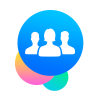Every time Facebook releases a new app, product, or service, I sigh. Facebook’s come a long way since graduating from college, but Zuckerberg has never ceased to give up hope that Facebook can become the be all, end all of communication. The company’s even resorted to buying some of the biggest names in communication (WhatsApp, Instagram) in order to have control of the market. But from one project to the next, Facebook continues to disappoint when it comes to adding innovative products or services to the market. When will Zuckerberg stop? It doesn’t look like anytime soon.
His next venture is Facebook at Work, an all-in-one solution to the problem of workplace productivity. Will it succeed? Given Facebook’s track record of misguided attempts at recreating already popular social apps, I’m not very confident. See for yourself.
Facebook Deals (April 2011- Aug 2012)
The little known Facebook deals appeared in only 5 US cities as a way to compete with Groupon and Living Social, providing coupons and deals for local businesses. If you’re wondering why it never came to your city, it’s because the project closed just 4 months after it’s launch.
Level of success: FAILURE
 Messenger (Aug 2011-)
Messenger (Aug 2011-)
Messenger was the first addition to Facebook’s set of apps back in August 2011. It stood as an optional stand-alone app to better optimize the Facebook messenger experience. In July 2014, Facebook completely removed Messenger from its mobile app, forcing users to download Messenger separately (and angering many in the process). Since November, Facebook’s pedaled backwards a bit, once again allowing Messenger access from Facebook’s Android app. Over the years, Messenger has gained enough functionality to be considered a messaging app on it’s own, with the ability to make voice calls, video chat, and share photos and video.
Rank in Google Play: #1 in Communication, #2 Overall in US
Rank in App Store: #1 US Social Networking, #4 Overall in US
Level of success: HIGH
 Camera (May 2012- May 2014)
Camera (May 2012- May 2014)
If you’ve never heard of Facebook Camera, you’re not the only one. The app was released for iPhone in May 2012 as a competitor to the then already booming Instagram (which curiously, Facebook had just purchased). It did basically the exact same thing as Instagram: photo feeds with the ability to like or comment, tag a person, add a location, or add filters. It’s biggest caveat was that there was no discovery function, only showing you photos from your friends, essentially making it a lesser Instagram. It got barely any buzz and just as little protest when it was killed off in May 2014, but some of its token features, like the image picker, have since been integrated into Facebook’s mobile app.
Rank in App Store, May 2014: #304 in US Photo and Video
Level of success: FAILURE
 Facebook Pages Manager (May 2012-)
Facebook Pages Manager (May 2012-)
If you manage any Facebook pages, there’s an app for that. Facebook Pages Manager is a separate app that lets you– you guessed it– manage Facebook pages. It’s a bit of a niche app, as not everyone is a page manager or administrator, but it’s still around and useful if you need to manage a page on mobile.
Rank in Google Play: #2 in US Business, #498 Overall in US
Rank in App Store: #6 in US Business, #358 Overall in US
Level of success: MODERATE
 Poke (Dec 2012- May 2014)
Poke (Dec 2012- May 2014)
The innocuous Poke became a standalone app from Facebook in 2012. What started as a joke (and then continued to be one), the app was Facebook’s first attempt at a direct competitor for Snapchat, letting you send self-destructing images, videos and messages to your Facebook friends. Alas, Poke proved to be no real competitor for Snapchat and hung around longer than expected in the App Store until it was quietly removed, along with Camera, in May 2014.
Rank in App Store, May 2014: #469 in US Social Networking
Level of success: FAILURE
 Home (April 2013-)
Home (April 2013-)
Almost like an Android Launcher, Facebook released Home in April 2013 for HTC and Samsung devices, bringing your Facebook News Feed to the home screen of your Android device. It was basically designed for super heavy Facebook users, with Chat Heads being one of the key takeaways from the app. The concept was a bit murky, and while it’s still around, there has been no added support for other Android devices, and no update since 2013. It looks like Facebook may have abandoned Home.
Rank in Google Play: #229 in US Social Apps
Level of success: LOW
 Paper (Jan 2014-)
Paper (Jan 2014-)
Once Facebook execs realized just how many people were consuming their news via Facebook, the social network released it’s own news app in the form of Paper. Having been released with a lot of hype for iPhone and exclusively in the US in January 2014, Paper mixes stories from your News Feed and other news categories of your choice to offer a more personalized news experience. The app itself is fully functional, with swipe gestures that streamline the Facebook experience, but it still doesn’t compete with the simplicity and ease of use of news aggregators like Feedly or Flipboard. While still around, the app’s been stagnant since its launch over a year ago. With still no word about an international or Android launch, I wouldn’t be surprised if this one quietly died too.
Rank in App Store: #31 in US News
Level of success: MODERATE
 Mentions (July 2014-)
Mentions (July 2014-)
Unless you’re a celebrity or star athlete, you probably won’t know about Mentions. It’s an iOS-only app made specifically for verified public figures using Pages, letting them (or their wranglers) see what fans are saying about them and join in on the conversation. I can’t vouch for it’s usefulness because sadly, I am not an important public figure, but if in your News Feed you mention something about a celebrity and they happen to respond, that means they’re probably using the app. Think of it as Twitter mentions for Facebook. Because it was only launched in July in the US, whether or not it’s viable or useful has yet to be seen.
Rank in App Store: #184 in US Social Networking
Level of success: MODERATE
 Slingshot (June 2014-)
Slingshot (June 2014-)
Facebook’s 2nd attempt at a Snapchat competitor (or 3rd, if you consider it’s attempt to buy Snapchat) came in June 2014 in the form of Slingshot for Android and iOS. Much like Poke before it, Slingshot lets you share self-destructing messages. The novelty of it is reciprocity. To open a message, you have to send one yourself first, supposedly encouraging more sharing. Or not.
Since it’s launch, Slingshot has removed the share-to-unlock requirement of the app, and although it’s an attractive, properly functioning alternative to Snapchat, the numbers show that it can’t compete with the real thing.
Rank in Google Play: #317 in US Social Apps
Rank in App Store: #522 in US Social Networking
Level of success: LOW
 Rooms (Oct 2014-)
Rooms (Oct 2014-)
Rooms is Facebook’s attempt at recreating the 90’s chat room of yesteryear, letting you use an ambiguous identity to contribute to rooms about different topics accessible only via QR codes. The contribution is largely based on images, and the chat is fairly limited. Personally, I’m not a big fan of the app so far. It’s been rumored that Facebook saw an opportunity in the market with the success of Yik Yak, the anonymous hyper-local ‘news’ app that has been taking college campuses by storm, but not much has been said post-launch.
Rank in App Store: #273 in US Social Networking
Level of success: LOW
 Groups (Nov 2014-)
Groups (Nov 2014-)
Facebook’s latest addition to the app world is Groups, a standalone app that lets manage your Facebook groups to create a private space for sharing with family and friends, almost like your very own private News Feed. The app looks nice enough, but whether or not people use groups enough to justify a separate app (or want one) is another question. So far, it’s doing okay, but the jury’s still out on this one.
Rank in Google Play: #33 in US Social, #469 Overall in US
Rank in App Store: #20 in US Social, #167 Overall in US
Level of success: MODERATE (so far)
Facebook at Work (Jan 2015)
Not so much an app as it is a new Facebook experience, Facebook is planning to launch Facebook at Work early next year. In what many have cited as the time wasting properties of Facebook, the company is hoping to create a kind of workspace to connect colleagues on projects in real-time, without having to worry about the distractions of cat videos or vacation photos. It’s like a combination of LinkedIn and Google Drive services that aim to make collaboration in the workplace easier, as well a place to make contacts. It’s potential has also been compared to Microsoft’s Outlook and Lync for services.
Level of success: TBD
Yes, quit while you’re ahead
Some you may use, others you may have heard about, while some have quietly drifted away in obscurity, but there’s no denying one common thread: Snapchat, Instagram, Twitter, Linkedin, Yik Yak, and the like– Facebook’s app’s aren’t so much new innovations as they are attempts to recreate already successful apps that it couldn’t manage to buy, banking on the Facebook name to carry it forward.
Facebook at Work doesn’t seem much different. The potential key to its success, presumably, could be a melding of all of the above mentioned services (LinkedIn, Google Drive, Outlook and Lync) into one huge place for productivity, an usual approach for Facebook in that it could actually add value, instead of further saturating an already full market with another clone. We’ll have to wait until next year to see how it works, but based on its track record, I won’t hold my breath.
I do have to give it to Facebook though: they’ll try anything once (or twice). I guess when you have enough money, failure is an option.
*Note, app rankings are via App Annie and correspond with the rankings as of the day of publication.
Related articles:
What’s all the yakking about Yik Yak?
Why Rooms is not the future of anonymous chat
Follow me on Twitter: @suzieblaszQwicz


